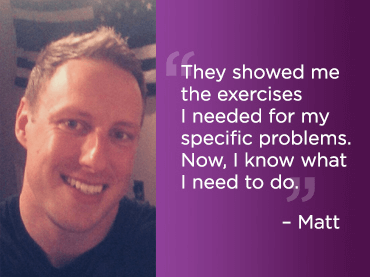Easing Neck Pain Without Surgery
For Matt Salerno, one of the toughest parts about his job as a police officer are the hours spent sitting in a patrol car and wearing 30 pounds of equipment — including a tight, heavy, bullet-proof vest. It all added up to neck pain radiating into his shoulder and back.
“It became a constant aching pain,” says Matt, 38. “It was hard to focus. I was thinking about the pain all the time.”
Over the course of four years, Matt sought help from two different chiropractors and consulted an orthopaedic doctor. He even tried some physical therapy. Although he felt temporary relief, the neck pain kept flaring up.
Finally in 2021, his primary care doctor referred him to the UPMC Program for Spine Health, which offers a nonoperative approach to neck and back pain.
“I thought everyone did a good job. They showed me the exercises I needed for my specific problems,” — Matt
Schedule an Appointment or Ask a Question
A different approach
The UPMC Program for Spine Health takes a different approach to spine pain. Instead of focusing on pain or looking at one part of the body, it takes the entire patient into account. The goal is to help patients understand their problem and empower them with knowledge and tools they can use to regain function and feel better.
A resident of the South Hills, Matt initially met with Karen Barr, MD, a specialist in physical medicine and rehabilitation, at the program’s Bethel Park location at the UPMC Outpatient Center. She recommended that he begin working with one of its physical therapists. Known as primary spine practitioners, they are specially trained in the complexities of spine care.
Bill Dileonardo, PT, OT, also saw Matt at the Bethel Park location. He began with a thorough evaluation of Matt’s pain issues before starting physical therapy.
“Previously, everyone had focused on Matt’s neck,” says Bill. “We didn’t just look at his neck. We looked at the entire spine and how he was moving. We looked at how his spine bends forward and backward, and how it rotates. We looked at his hips, his feet and ankles, and whole posture to see what was contributing to his pain.”
Taking charge
Matt, a serious weightlifter since age 15, knew he was strong. But he learned that his lack of flexibility was causing issues in his mid-back and spine that led to his neck pain.
At weekly physical therapy sessions over two months, Bill worked with Matt on flexibility with stretching exercises that he could add to his weightlifting regimen. He also provided guidance on home remedies he could use, including purchasing an orthopaedic pillow to help with posture during sleep. Matt also purchased his own electrical muscle stimulation device so he could recreate that treatment at home for mild pain relief.
“I thought everyone did a good job. They showed me the exercises I needed for my specific problems,” says Matt. “I know what I need to do. It’s something I’ll have to manage.”
After three or four sessions, Matt was feeling much better. At his two-month follow-up appointment with Dr. Barr he reported he was 80% improved. Three months later, he was 95% better. He no longer needed to rely on anti-inflammatory medicine and muscle relaxers.
“Matt was a good patient because he listened. He was good about doing his exercises and working on flexibility,” says Bill.
“He was diligent and stuck to the program. That helped him get better quickly.”
Read more stories from UPMC Program for Spine Health patients.

















